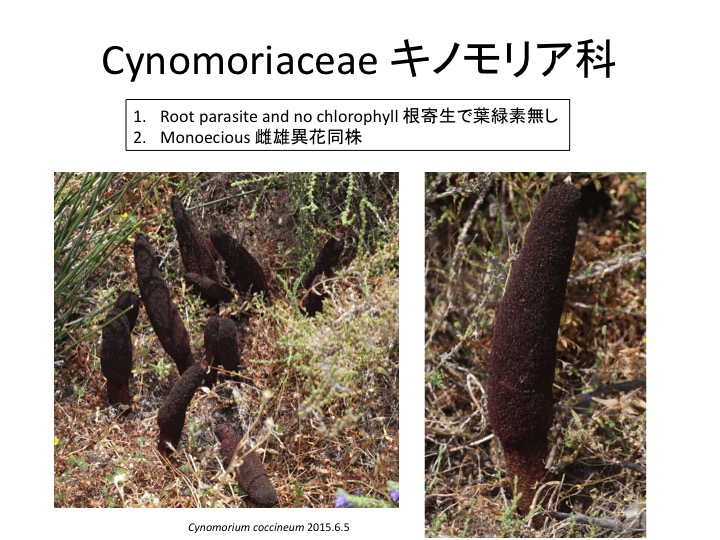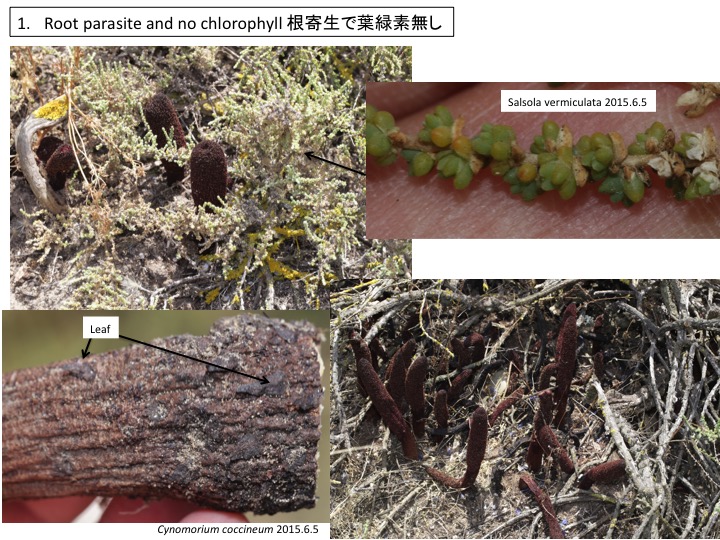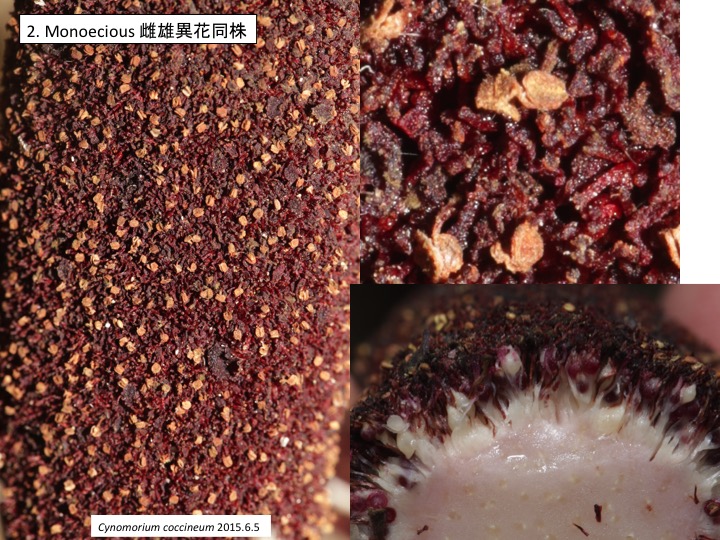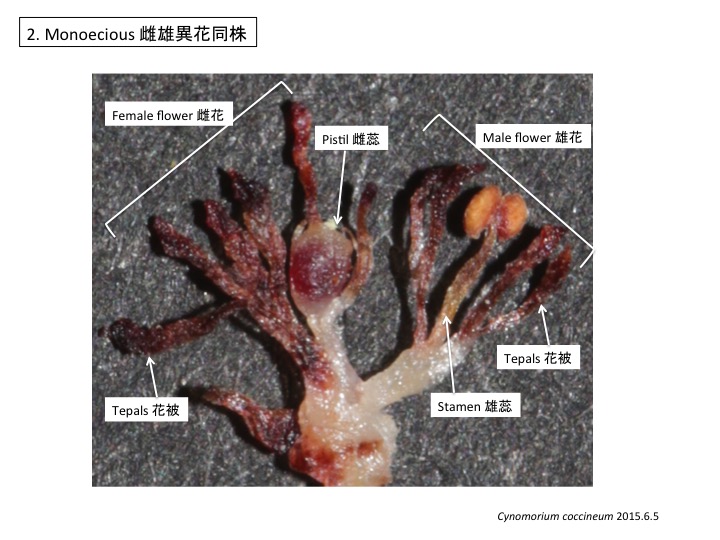本ページ作成にあたり、自生地を案内いただいたIñigo Sanchez Garcia博士、 Joaquin Medina博士、 Jesus Vincente Carbajosa博士に心より感謝申し上げます。
キノモリア科は2種が地中海から中央アジアまで分布する。広域に分布すること、形態が単純であることから、隠蔽種を含んでいる可能性もある。
キノモリア科の他の科との系統関係はまだ不明である。葉緑体ゲノムのInverted Repeat配列比較からはバラ科に近縁(Zhang et al. 2009; Moore et al. 2011) 、核のリボゾームDNAやミトコンドリアDNA配列比較からはベンケイソウ科に近縁(Barkman et al. 2007; Nickrent et al. 2005)という結果が報告されている。
I really appreciate Drs. Iñigo Sanchez Garcia, Joaquin Medina, and Jesus Vincente Carbajosa for their kindness to take me to the locality of Cynomorium coccineum.
The Cynomoriaceae contains only two species, even though they are widely distributed from Mediterranean to Central Asia. Studies on genetic diversity in this family may reveal some cryptic species.
Phylogenetic position of the Cynomoriaceae is still ambiguous. Inverted repeat structure of chloroplast genomes supports a sister relationship to the Rosaceae (Zhang et al. 2009; Moore et al. 2011) but phylogenetic inferences with nuclear ribosomal DNAs and mitochondrial genes support close relationship to the Crassulaceae (Barkman et al. 2007; Nickrent et al. 2005).
Barkman, T.J., McNeal, J.R., Lim, S.H., Coat, G., Croom, H.B., Young, N.D., DePamphilis, C.W. 2007. Mitochondrial DNA suggests at least 11 origins of parasitism in angiosperms and reveals genomic chimerism in parasitic plants. BMC Evol Biol 7:248.
Moore, M.J., Hassan, N, Gitzendanner, M.A., Bruenn, R.A., Croley, M., Vandeventer, A., Horn, J.W., Dhingra, A., Brockington, S.F., Latvis, M., Ramdial, J., Alexandre, R., Piedrahita, A., Xi, Z., Davis, C.C., Soltis, P.S., & Soltis, D.E. 2011. Phylogenetic analysis of the plastid inverted repeat for 244 species: Insights into deeper-level angiosperm relationships from a long, slowly evolving sequence region. Int. J. Plant Sci. 172: 541-558.
Nickrent, D.L., Der, J.P., and Anderson, F.E. 2005. Discovery of the photosynthetic relatives of the “Maltese mushroom” Cynomorium. BMC Evol Biol 5: 38.
Zhang, Z.-H., Li, C.-Q., and Li, J. 2009. Phylogenetic placement of Cynomorium in Rosales inferred from sequences of the inverted repeat region of the chloroplast gene. J. Syst. Evol. 47: 297-304.
スペイン南部の海外のCynomorium coccineum。この場所でのホストはオカヒジキ属のSalsola vermiculata であるが、キク科、Tamaricaceae、マメ科、イソマツ科もホストにする。ときどき寄生されて枯れているSalsola vermiculataも見られる。
A host plant of Cynomorium coccineum in this place is Salsola vermiculata in the Polygonaceae. Cynomorium also has host plants in the Asteraceae, Tamaricaceae, Fabaceae, and Plumbaginaceae. Salsola verniculata sometimes die likely because of Cynomorium.
雄花、雌花、両性花を形成する(Nickrent et al. 2005)。花弁は痕跡的で何の役割をしているのだろうか。
Male, female, and hermaphrodite flowers are formed (Nickrent et al. 2005). Tepals are tiny and what is their function?
Nickrent, D.L., Der, J.P., and Anderson, F.E. (2005). Discovery of the photosynthetic relatives of the “Maltese mushroom” Cynomorium. BMC Evol Biol 5, 38.




